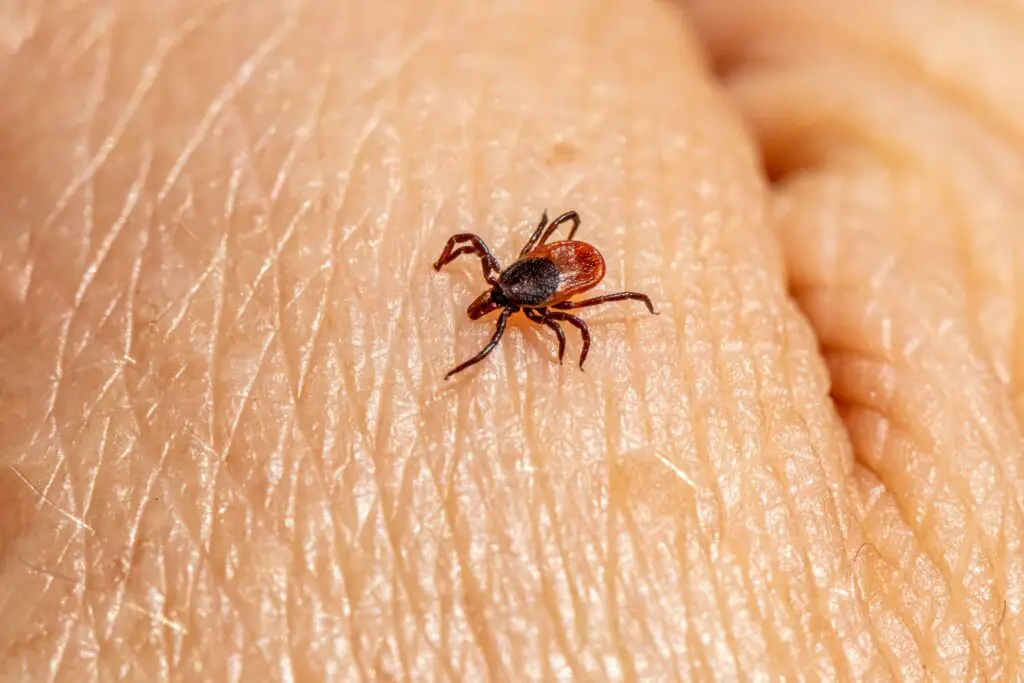Nature is the home to an incredibly versatile array of species, but ticks are definitely one of those that we tend to avoid at all costs.
These tiny arachnids, that are related to spiders, mites, and scorpions, are in fact parasites that survive by attaching themselves to larger animals and feeding on their blood. Humans aren’t spared either. Sadly, these insects carry harmful bacteria that can spread disease to people.
Sadly, tick-borne diseases are at an all-time high, with about 50,000 cases reported each year, and far more going unreported.

There are different types of ticks, and unfortunately, they sometimes find their way to people’s homes. The types most commonly found in homes are the black-legged tick, the dog tick, and the brown dog tick.
- Black-legged Ticks – known as deer ticks, these ticks are typically brown or black in color and have a flattened, oval-shaped body. They are commonly found in wooded areas and can transmit Lyme disease.
- Dog Ticks are larger and can range in color from brown to reddish-brown. They have a tough, shield-shaped body. Dog ticks can transmit diseases such as Rocky Mountain spotted fever.
- Brown Dog Ticks are brown in color and have a slender body.
Although the tick season is between March and October, or sometimes longer, we should be wary of this insects all year round. In fact,if beaten by a tick, a person can develop symptoms even after two or three months.

The bite itself isn’t painful and can cause swelling, itchiness, blistering, and bruising. The bad thing is that ticks also carry and transmit severe diseases, most commonly Lyme disease, as well as Rocky Mountain spotted fever, ehrlichiosis, and babesiosis.
Initially, Lyme disease develops as a circular red ‘bull’s eye’ rash around the site of a tick bite. However, not everyone gets a rash and you should also watch out for a flu-like illness with fever, headache, tiredness and general aches and pains.
The best way to prevent being bitten by a tick is to avoid tall grasses and areas where ticks thrive (such as moorlands and woodlands), especially during the warmer months.
In case you do get bitten, you should remove the tick as soon as possible in order to prevent infections.

These are some of the ways of safe removal.
- Use fine-tipped tweezers: Use clean, fine-tipped tweezers to grasp the tick as close to the skin as possible.
- Pull gently: Apply steady upward pressure, being careful not to squeeze or crush the tick. Aim to remove the tick in one smooth motion without twisting or jerking. Twisting or jerking can cause the tick’s head to break off and stay inside the skin, where it can still transmit disease.
- Clean the area: After removing the tick, clean the affected area with soap and water or an antiseptic solution. Monitor the site of the bite for any signs of infection or a rash, and consult a healthcare professional if necessary.

If by any chance ticks find their way into your home, take immediate action in order to prevent infestation. Most times, ticks are brought into your home in case they stick on your clothes or onto your pets.
- Isolate the area: If you have identified the presence of ticks in a specific area, keep pets and children away from that space.
- Wear protective gear: Put on gloves and a long-sleeved shirt to protect yourself from potential tick bites.
- Clean the area: Clean the area where you found the tick. If it is in bedding, wash the sheets. Inspect the area to ensure there are no more ticks that are present. Dispose of the tick by either flushing it down the toilet or sealing it in a container or ziplock bag before placing it in the trash.
Woman’s Bikini Beach Pic Shared By Thousands & It’s Easy To Understand Why

Few of the beach photographs that many women share on social media become viral. Thousands of people shared a coastal photo that a lady had uploaded of herself in a bathing suit quite rapidly, and it’s understandable why the image went viral when you saw it in its entirety.

Aimee Copeland hasn’t always felt at ease with her body, like many women do, and she has good cause to be uneasy. According to Cosmopolitan, the then-24-year-old graduate student at the University of Georgia, who was pursuing a master’s degree in psychology, met a horrible end in May 2012 when she and her companions hopped onto a makeshift zip line they discovered in a Carrollton, Georgia, creek. Regretfully, Aimee’s appearance would be permanently altered by the accident.

The zip line, which was compared to “not much more than a dog wire with handlebars,” broke during Aimee’s second turn. Aimee told People that she suffered a serious gash on her calf after colliding with the jagged rocks below. Unfortunately, the young woman did not realize at the moment how arduous the path ahead would be for her. Aimee was sent home after having her wounds treated with 22 surgical staples, but she couldn’t get rid of the sensation that “something just didn’t feel right” in her leg.


Aimee woke up three days later with blood blisters on her left leg. She couldn’t speak, and oddly, her tongue was “shriveled up in her mouth.” Naturally, Aimee was hurried to the hospital to obtain clarification. There, a very rare flesh-eating bacterial illness known as necrotizing fasciitis was identified in her medical history. If left untreated, this illness can swiftly become lethal.
Aimee’s body was being severely damaged by a life-threatening illness, therefore all of her limbs were amputated in an attempt to preserve her life. It worked, but the young woman lost her right leg, left foot, and both hands, leaving her permanently and badly scarred. But instead of succumbing to the natural deep melancholy that such awful circumstances would bring on, Aimee made the decision to fight for her life and never give up.
“I refused to allow anything to impede my progress. Aimee clarified, “There’s always hope for tomorrow and that enduring impulse to keep trying and never give up.
Aimee shared details of her arduous and protracted recuperation on social media; nevertheless, certain aspects of her story proved more challenging to disclose than others, including pictures displaying all of her amputations and scars. Years after her accident, nevertheless, she made that precise decision. Aimee shared a happy photo of herself while on vacation in Puerto Rico to commemorate her journey of body acceptance and love.
Aimee, wearing a two-piece bikini, grinned for the camera while exposing every inch of her body, including her scars and amputations, in an effort to encourage people to embrace their bodies for what they are, warts and all.
Aimee wrote, “It has taken me a long time to become comfortable with and accept my new body,” as the photo’s caption, reassuring everyone that their bodies are ready for the beach no matter how they may appear. “There is great beauty in our defects because we are all made flawed. Character is developed by the skin grafts and scars! What matters most is what you do with what you have; possessions are not as important as actions.


According to Metro, Aimee Copeland started her career as a public speaker and an advocate for people with disabilities following her devastating zip-lining accident, which resulted in amputations. She still serves as an inspiration to others through her social media posts and public speaking engagements, more than ten years after her injuries. Apart from her advocacy work, Aimee chose to study for a Ph.D. in psychology at the University of West Georgia, demonstrating that no matter what unfortunate events we encounter, we can still achieve success and realize our aspirations.
Aimee clarified, “I’ve let go of the girl I was before.” “I’ve accepted who I am in its entirety.”
Kudos to this young lady for being a multifaceted inspiration. Aimee not only radiates unending optimism in the midst of extreme hardship, but she also serves as a reminder to all of us that we can accept our flaws and find beauty in the distinctive forms that make up our bodies. She also shows that, if we have the proper mindset regarding our difficulties in mind, we can work hard to overcome any challenge we may encounter. She triumphed against tragedy, and we can too.



Leave a Reply